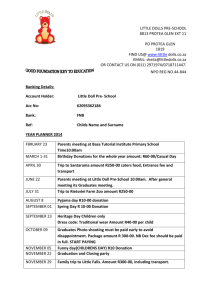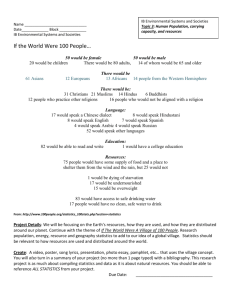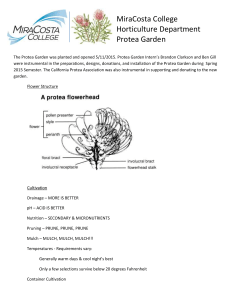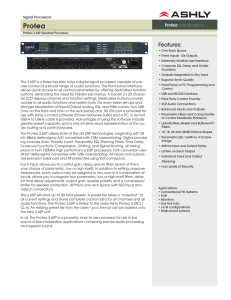a short history
advertisement
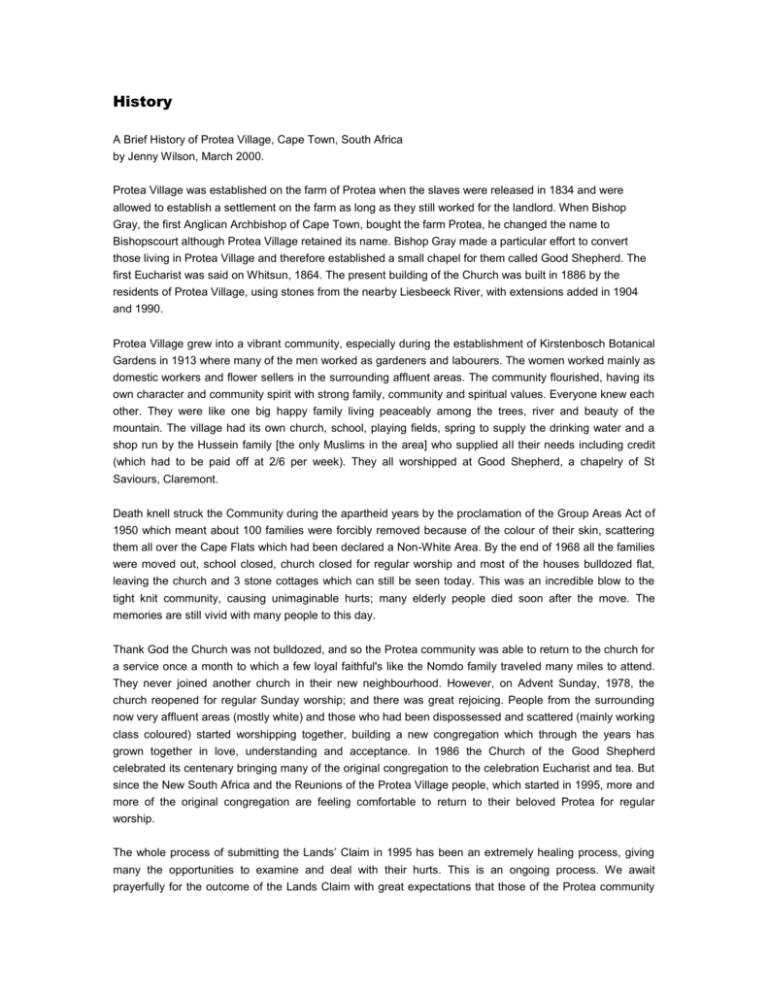
History A Brief History of Protea Village, Cape Town, South Africa by Jenny Wilson, March 2000. Protea Village was established on the farm of Protea when the slaves were released in 1834 and were allowed to establish a settlement on the farm as long as they still worked for the landlord. When Bishop Gray, the first Anglican Archbishop of Cape Town, bought the farm Protea, he changed the name to Bishopscourt although Protea Village retained its name. Bishop Gray made a particular effort to convert those living in Protea Village and therefore established a small chapel for them called Good Shepherd. The first Eucharist was said on Whitsun, 1864. The present building of the Church was built in 1886 by the residents of Protea Village, using stones from the nearby Liesbeeck River, with extensions added in 1904 and 1990. Protea Village grew into a vibrant community, especially during the establishment of Kirstenbosch Botanical Gardens in 1913 where many of the men worked as gardeners and labourers. The women worked mainly as domestic workers and flower sellers in the surrounding affluent areas. The community flourished, having its own character and community spirit with strong family, community and spiritual values. Everyone knew each other. They were like one big happy family living peaceably among the trees, river and beauty of the mountain. The village had its own church, school, playing fields, spring to supply the drinking water and a shop run by the Hussein family [the only Muslims in the area] who supplied all their needs including credit (which had to be paid off at 2/6 per week). They all worshipped at Good Shepherd, a chapelry of St Saviours, Claremont. Death knell struck the Community during the apartheid years by the proclamation of the Group Areas Act of 1950 which meant about 100 families were forcibly removed because of the colour of their skin, scattering them all over the Cape Flats which had been declared a Non-White Area. By the end of 1968 all the families were moved out, school closed, church closed for regular worship and most of the houses bulldozed flat, leaving the church and 3 stone cottages which can still be seen today. This was an incredible blow to the tight knit community, causing unimaginable hurts; many elderly people died soon after the move. The memories are still vivid with many people to this day. Thank God the Church was not bulldozed, and so the Protea community was able to return to the church for a service once a month to which a few loyal faithful's like the Nomdo family traveled many miles to attend. They never joined another church in their new neighbourhood. However, on Advent Sunday, 1978, the church reopened for regular Sunday worship; and there was great rejoicing. People from the surrounding now very affluent areas (mostly white) and those who had been dispossessed and scattered (mainly working class coloured) started worshipping together, building a new congregation which through the years has grown together in love, understanding and acceptance. In 1986 the Church of the Good Shepherd celebrated its centenary bringing many of the original congregation to the celebration Eucharist and tea. But since the New South Africa and the Reunions of the Protea Village people, which started in 1995, more and more of the original congregation are feeling comfortable to return to their beloved Protea for regular worship. The whole process of submitting the Lands’ Claim in 1995 has been an extremely healing process, giving many the opportunities to examine and deal with their hurts. This is an ongoing process. We await prayerfully for the outcome of the Lands Claim with great expectations that those of the Protea community who wish to return will be able to do so, even if not to their original homes perhaps to an Old Age Complex to be built as a memorial to the community of Protea Village.
